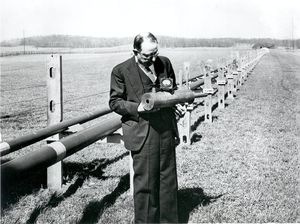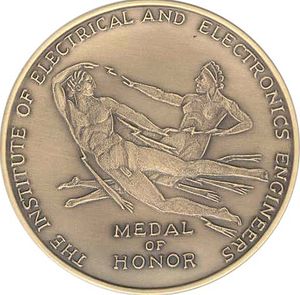George C. Southworth: Difference between revisions
No edit summary |
No edit summary |
||
| (6 intermediate revisions by 3 users not shown) | |||
| Line 1: | Line 1: | ||
== | == Biography == | ||
[[Image:2179 - Southworth.jpg|thumb|right|George Southworth testing a waveguide]] | |||
[[Image:MedalOfHonor.jpg|thumb|right|IEEE Medal of Honor]] | |||
<p>Born: 24 August 1890 <br>Died: 06 July 1972 </p> | |||
<p>Radio waves are said to be electromagnetic waves because they consist of variations in electric and magnetic fields. Electromagnetic waves can travel through the air (as they do when radio and television signals are broadcast, for example) or even a vacuum. Electromagnetic waves can also travel along an electric wire. That’s what happens with telephone lines. There is, it turns out, a third, completely different, way of transmitting electromagnetic waves: the [[Waveguides|waveguide]]. The person most responsible for developing [[Waveguides|waveguides]] was [[Bell Labs|Bell Labs]] engineer George Clark Southworth. </p> | |||
<p>Southworth was born on 24 August 1890 in Little Cooley, Pennsylvania. He studied physics at Grove City College, earning bachelor’s and master’s degrees. After working a year or so for the radio section of the National Bureau of Standards, he became an instructor at Yale University in 1918. There he studied radio waves of very short wavelength and completed a Ph.D in 1923. He then went to work for AT&T where he came to specialize in the transmission of very high frequency electromagnetic waves. </p> | |||
<p>It was for transmitting microwaves that Southworth developed waveguides. With transmission through the air (as in radio broadcasting) there is considerable wasted energy because the waves necessarily spread out to some extent. With transmission through wires there are significant losses, especially at the higher frequencies of microwaves. But a waveguide, essentially a hollow metal pipe, channels the microwaves effectively and reduces transmission losses by a factor of five or so. </p> | |||
[[Category: | <p>The waveguides of George Southworth became very important in radar systems during World War II. In 1964 the IEEE awarded him its [[IEEE Medal of Honor|Medal of Honor]]. He died on 6 July 1972 in Chatham, New Jersey. </p> | ||
[[Category:Dielectrics]] | |||
[[Category: | [[Category:People and organizations|Southworth]] [[Category:Engineered materials & dielectrics|Southworth]] [[Category:Dielectrics|Southworth]] [[Category:Dielectric devices|Southworth]] [[Category:Dielectric constant|Southworth]] [[Category:Fields, waves & electromagnetics|Southworth]] [[Category:Radio astronomy|Southworth]] [[Category:News|Southworth]] | ||
[[Category: | |||
Revision as of 19:06, 18 January 2012
Biography
Born: 24 August 1890
Died: 06 July 1972
Radio waves are said to be electromagnetic waves because they consist of variations in electric and magnetic fields. Electromagnetic waves can travel through the air (as they do when radio and television signals are broadcast, for example) or even a vacuum. Electromagnetic waves can also travel along an electric wire. That’s what happens with telephone lines. There is, it turns out, a third, completely different, way of transmitting electromagnetic waves: the waveguide. The person most responsible for developing waveguides was Bell Labs engineer George Clark Southworth.
Southworth was born on 24 August 1890 in Little Cooley, Pennsylvania. He studied physics at Grove City College, earning bachelor’s and master’s degrees. After working a year or so for the radio section of the National Bureau of Standards, he became an instructor at Yale University in 1918. There he studied radio waves of very short wavelength and completed a Ph.D in 1923. He then went to work for AT&T where he came to specialize in the transmission of very high frequency electromagnetic waves.
It was for transmitting microwaves that Southworth developed waveguides. With transmission through the air (as in radio broadcasting) there is considerable wasted energy because the waves necessarily spread out to some extent. With transmission through wires there are significant losses, especially at the higher frequencies of microwaves. But a waveguide, essentially a hollow metal pipe, channels the microwaves effectively and reduces transmission losses by a factor of five or so.
The waveguides of George Southworth became very important in radar systems during World War II. In 1964 the IEEE awarded him its Medal of Honor. He died on 6 July 1972 in Chatham, New Jersey.

